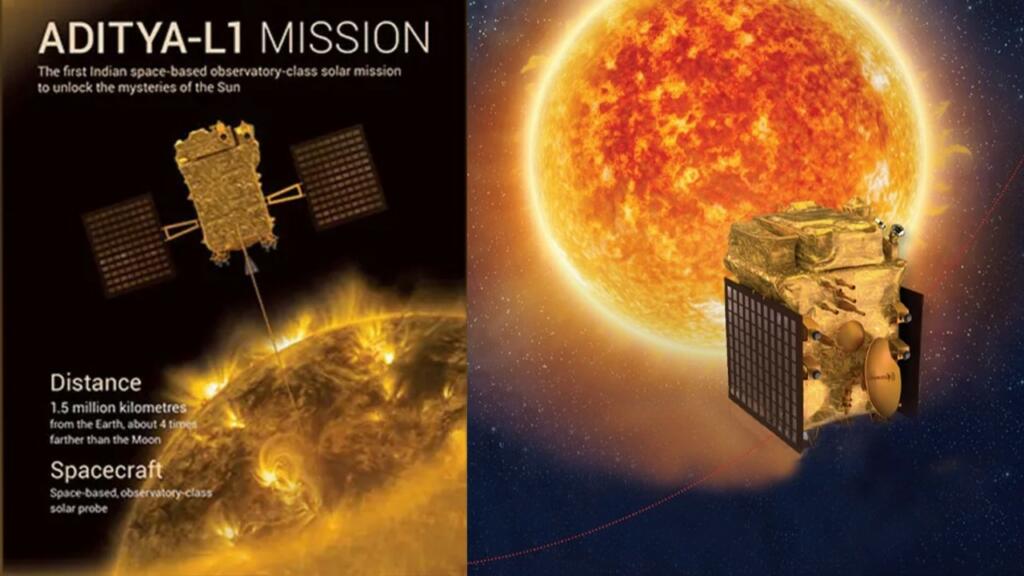Basking in the glory of Chandrayaan 3’s historic triumph, ISRO is now poised to set its sights on a new celestial endeavor – one that promises to unravel the mysteries of the fiery heart of our solar system. Prepare to be amazed, as India gears up for its maiden solar exploration mission, Aditya L1. Yes, you read that right – we’re heading to the Sun Mission!
Aditya L1 will be a pioneering venture, as it marks India’s first-ever space-based mission dedicated to studying the Sun. To achieve this feat, the spacecraft will be positioned at a strategically calculated point – Lagrange point 1 or L1 of the Sun-Earth system. Nestled 1.5 million kilometers away from our planet, this unique vantage point offers unobstructed and continuous observation of solar activities.
From solar flares to the enigmatic solar wind, Aditya L1 is primed to unlock a wealth of insights about the Sun’s intricate dynamics, paving the way for groundbreaking discoveries that will rewrite our understanding of the cosmos.
The upcoming Aditya L1 mission is set to propel India’s solar exploration efforts to new heights, armed with a payload of seven cutting-edge instruments. Each of these payloads is tailored to scrutinize distinct facets of the Sun – from its scorching surface to its elusive outer layers. Through these observations, scientists aim to decode the enigmatic behavior of our nearest star and its impact on our planet.
As elucidated on the Indian Space Research Organisation’s (ISRO) website, the primary objectives of Aditya L1 encompass a wide range of solar phenomena. The satellite’s seven payloads are designed to:
- Study the Upper Atmospheric Dynamics: This involves examining the chromospheres and corona of the Sun, gaining insights into their intricate behaviors and interactions.
- Unravel the Physics of Plasma: Understanding the partially ionized plasma and the mechanisms behind events like coronal mass ejections (CMEs) and flares is crucial in deciphering the Sun’s dynamics.
- Probe the In-Situ Particle and Plasma Environment: Aditya L1 will gather data on particle dynamics emanating from the Sun, providing vital information for space weather studies.
- Explore the Solar Corona and its Heating Mechanisms: Scientists will delve into the physics behind the Sun’s corona and its intriguing heating mechanisms that have long puzzled researchers.
- Diagnostics of Coronal Plasma: Parameters such as temperature, velocity, and density of coronal and coronal loop plasma will be meticulously analyzed.
- Investigate the Development and Origin of CMEs: The mission aims to shed light on the evolution of coronal mass ejections and their origins.
- Decipher Solar Eruptive Events: By tracing processes across multiple layers, such as the chromosphere and extended corona, the mission aims to unravel the sequence of events leading to solar eruptions.
Furthermore, Aditya L1 is equipped with two types of payloads: Remote Sensing Payloads and In-situ Payloads. The Remote Sensing Payloads comprise four instruments:
- Visible Emission Line Coronagraph (VELC): This payload serves as both an imaging and spectroscopy tool for the corona. It enables researchers to capture the Sun’s corona in fine detail.
- Solar Ultraviolet Imaging Telescope (SUIT): With its capability for narrow and broadband imaging, SUIT will provide insights into the photosphere and chromosphere of the Sun.
- High-Energy L1 Orbiting X-ray Spectrometer (HEL1OS): This payload is equipped with a hard X-ray spectrometer that studies the Sun as a star, probing its high-energy emissions.
- Plasma Analyser Package for Aditya (PAPA): PAPA will analyze the composition of solar wind and study its properties.
As the Aditya L1 mission embarks on its journey to Lagrange point 1 (L1) of the Sun-Earth system, it carries the promise of unraveling the Sun’s mysteries like never before. With its intricate instruments and diverse payloads, this mission will not only enhance our understanding of solar dynamics but also contribute valuable insights into space weather and its implications on Earth. Aditya L1 stands as a testament to India’s dedication to scientific advancement and exploration, propelling the nation further into the realm of space research.
Support TFI:
Support us to strengthen the ‘Right’ ideology of cultural nationalism by purchasing the best quality garments from TFI-STORE.COM
